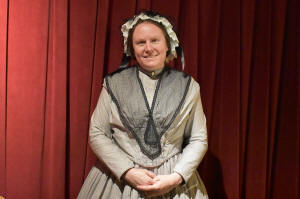|
The Lincoln Heritage Museum hosted
an historical interpretation of abolitionist Lucy Pettengill on
October 9 as part of their Journey to Freedom series sponsored by
the Looking for Lincoln Coalition. Pettengill was portrayed by Laura
F. Keyes, a librarian and historic voices presenter and lecturer
from Illinois. Keyes portrays nine different women and presents
lectures on a variety of subjects related to various aspects of
American history. On Thursday night, Keyes brought to life Peoria
abolitionist Lucy Pettengill in her Fighter for Freedom
presentation.
Keyes addressed the audience as if all were participating in a
ladies sewing circle operating as a cover for a clandestine
abolitionist meeting on March 22, 1857. Keyes wore period clothing
of a grey-striped hoop skirt and matching bodice, a bonnet of white
lace and black ribbon, and a black and white cameo at her throat.
She began her presentation to the “sewing circle” by reminding them
of the Dred Scott Supreme Court case in which Scott sued his
slaveowner for his and his wife’s freedom but lost his case due to
laws that stated enslaved people were not citizens and therefore did
not have constitutional rights, nor the right to sue. Keyes as
Pettengill entreated her audience, “To stand up against these unjust
laws!”

She read from a period newspaper
and reminded the audience how the Missouri Compromise which limited
the spread of slavery, was ruled unconstitutional, how Elijah
Lovejoy, a minister, journalist, and abolitionist, was killed by a
mob in Alton, Illinois defending the printing press upon which he
published an anti-slavery newspaper, as well as the number of
abolitionists in Quincy, Jacksonville, and other Illinois towns who
had faced threats and harassment for their views and activities.
“How do we live in a time in which we are worried about free
speech?” she asked.
Keyes as Pettengill then explained how Pettengill had come from New
York to Peoria in 1834 when it was still called Fort Clark and
consisted of 30 cabins and a few frame houses. She came to Illinois
with her husband, Moses, first traveling on a canal boat, then a
steamer, then a brig to Chicago. There they joined other families
traveling to Peoria by covered wagon with the men riding horseback
and ladies and children in the wagons. They arrived in June and
rented a room until they bought a cabin, then eventually built a
business and a house. Pettengill taught Sabbath School in the old
courthouse. With other residents, they organized the first
Presbyterian church, which was the first church established in
Peoria.

[to top of second column] |

Laura F. Keyes portrays Lucy Pettengill. Photo by Stephanie Hall

In 1837, the
Illinois Assembly adopted a resolution to condemn abolition
societies. That same year Elijah Lovejoy was killed. In 1842,
Pettengill’s church hired the Reverend William Allen, an
abolitionist, as the pastor of the Presbyterian church. The next
year, in 1843, a pro-slavery meeting accused Allen of disturbing
the peace. A mob approached the church with ill intent where an
anti-slavery meeting was being held despite constitutional laws
protecting free speech and freedom of assembly. This is the year
that the abolitionist focus moved to political action, however
the only active for the cause were women because it had become
dangerous for the men. Women could meet for "sewing circles” and
the like without suspicion. The women of Peoria then formed a
Female Anti-Slavery Society and after a state convention
coordinating the local societies, a school was opened in
Galesburg for black students
The Fugitive Slave Law of 1850 meant
slave owners and bounty hunters could pursue escaped slaves into
free states making it even more dangerous to journey north out of
slavery and to support the abolitionist cause. Pettengill and her
husband were part of the Underground Railroad guiding those seeking
freedom to safety and providing for their needs along the way.
Pettengill housed the people seeking freedom, allowing them to sleep
by the stove during the day, feeding them, and directing them to the
next safe house. She explained to the audience that the signal was a
tap at the window followed by whispering “a friend.” She encouraged
“the sewing circle” to provide filling food or portable food,
clothing, and information and directions to safe houses in Galesburg
or Farmington. She advised the group to keep crepe veils, long
gloves, and bonnets on hand to disguise day travel. She told the
group not to let the maid work at your home the day a fugitive
comes. She instructed the group not to write anything down, to stay
calm, and make measured decisions. Slave catchers do not watch
women, she said, so they may work quietly and unnoticed.
At the conclusion of the presentation, Keyes fielded questions from
the audience and posed for photographs. Lincoln Heritage Museum
Director Ron Keller invited the audience to explore the Journey to
Freedom exhibit displayed in a room adjacent to the museum. To learn
more about Historic Voices by Laura Keyes, visit
https://www.laurafkeyes.com/.
To learn more about the Lincoln Heritage Museum, visit
https://museum.lincolncollege.edu/.
[Stephanie Hall] |